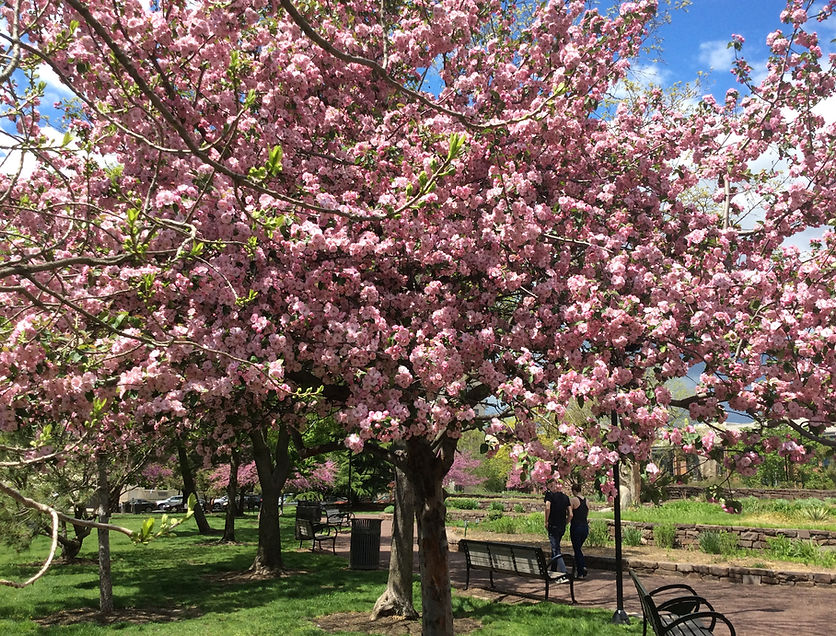top of page
Double Pink Cherry
Prunus serrulata 'Kwanzan'
There are two double pink cherry trees in the Park. See Wikipedia entry here.
The Kwanzan cherry has double pink flowers and a vase-shaped form with a rounded crown that spreads with age, making the tree wider than it is tall at maturity. The new leaves are bronze-colored, turning to dark green, then yellow, orange, or copper in the fall. This is a fruitless cultivar.

Cherry in the northwest corner of the Park in April. This cherry died and was cut down in September 2021.
Double pink cherry tree factoids:
-
The cherries are probably the easiest to identify with their multi-petaled flowers in the spring, their dark green serrated leaves in the summer, and their smooth purplish bark year round.
-
A wild cherry has five petals in the flower, but breeding has led to cherries like ours with up to 28 petals in each flower.
-
The ornamental cherry trees are bred for their showy flowers, and most do not bear fruit. Extra rings of petals develop instead of rings of stamens and pistils (or at least under-developed male and female parts) so that fruit is not formed. The reduced pollen and nectar in the flowers results in a noticeable decrease in bees around the cherry trees compared to the crabapple trees which bloom at the same time (see outside article here and compare the cherry and the adjacent crabapple trees in the southeast section of the park in late April).
-
In Japanese culture, the cherry blossoms, which only last about a week on each tree, signify the ephemeral.

Cherry tree bark from the other cherry in the northwest triangle, next to the flowering cherry in the photo above
The horizontal lines on the bark are called lenticels, and they permit direct exchange of gases between the atmosphere and the interior of the tree.

Cherry in southeast triangle in April, looking east, with the boughs drooping with the weight of the flowers.

Cherry in the northwest triangle in July with characteristic bark and leaves
The leaf on the left is showing its glossy deep green upper surface. The leaf on the right shows the matte lighter green undersurface.
Botany 101 Bonus
There are many physical attributes to examine to identify a tree, and there are many dichotomous tree identification algorithms on the internet. One can look at tree shape; deciduous versus evergreen; flowering versus not; leaf attachments to the branches; bark; and fruit appearance and ripening season. The chart below gives terminology in describing the leaf shape, edge, and vein pattern. Of course, Nature doesn't shoehorn herself into our exact descriptive categories, but the cherry leaf can be described as ovate-acuminate in shape, serrate on the edges, and arcuate as far as venation.

The crabapples and cherries can be hard to distinguish when young, as both have serrated leaves and smooth reddish bark. A clue to cherry tree identification is the presence of two or more small reddish bumps on the stem (petiole) of the leaf. These are extrafloral nectaries, meaning nectar secreting glands not in the flowers. The flowers of many plants offer nectar to pollinators as payment for the service of spreading the pollen to another tree. But flowers only last two or three weeks. The glands near the base of a cherry leaf offer nectar to ants, and these ants, while roaming the tree in search of this nectar, fend off other insects like tent caterpillars which can damage the tree. The ant gets paid with nectar for its protection services. For more on this symbiotic relationship between tree and ant, see outside link here.

The serrated edge of the cherry leaf is clearly seen. The two bumps on the petiole at the leaf base are the extrafloral nectaries that secrete nectar.
bottom of page


